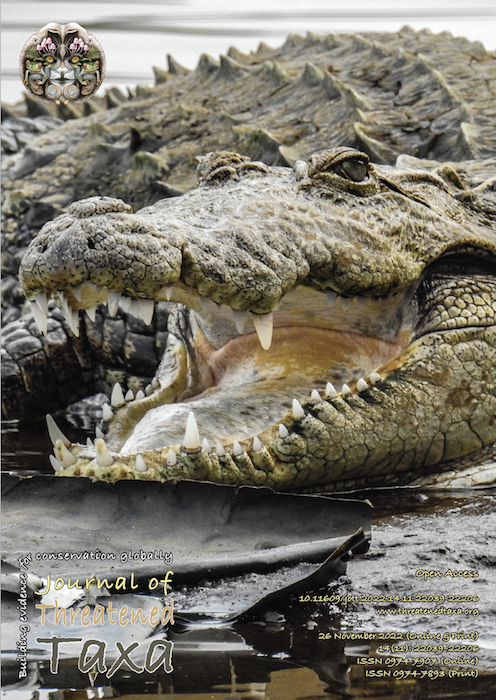Foraging activity and breeding system of Avicennia officinalis L. (Avicenniaceae) in Kerala, India
Main Article Content
Abstract
Field studies were carried out to assess the foraging activity and the breeding system of Avicennia officinalis L. in Chettuwa, Thrissur, India during the two flowering seasons of 2018–2019. A. officinalis, also known as the Indian mangrove is a common mangrove occupying the river banks of the Kerala coast of southern India. The plant blooms massively during the onset of the first summer showers. The flowering to fruiting period lasted from April to July. Bagging experiments revealed that A. officinalis preferred a mixed breeding system though they had a low fruit set recorded in self-pollination experiments. A total of 15 species of foraging insects belonging to three orders, Hymenoptera, Diptera, and Lepidoptera, were observed. The three most abundant insect foragers were Apis florea Fabr., Campsomeriella collaris Fabr., and Chrysomya megacephala Fabr. Among these, A. florea showed a significantly high visitation rate followed by C. collaris and then C. megacephala. C. collaris, however, had the highest and most significant handling time for Avicennia officinalis than A. florea. The peak foraging activity was recorded from 1000h to 1100h and from 1500h to 1700h. These findings emphasize the importance of insect flower visitors in the breeding of A. officinalis, highlighting the need to maintain the plant-pollinator relationships for the protection of mangrove ecosystems.
Article Details

This work is licensed under a Creative Commons Attribution 4.0 International License.
Authors own the copyright to the articles published in JoTT. This is indicated explicitly in each publication. The authors grant permission to the publisher Wildlife Information Liaison Development (WILD) Society to publish the article in the Journal of Threatened Taxa. The authors recognize WILD as the original publisher, and to sell hard copies of the Journal and article to any buyer. JoTT is registered under the Creative Commons Attribution 4.0 International License (CC BY), which allows authors to retain copyright ownership. Under this license the authors allow anyone to download, cite, use the data, modify, reprint, copy and distribute provided the authors and source of publication are credited through appropriate citations (e.g., Son et al. (2016). Bats (Mammalia: Chiroptera) of the southeastern Truong Son Mountains, Quang Ngai Province, Vietnam. Journal of Threatened Taxa 8(7): 8953–8969. https://doi.org/10.11609/jott.2785.8.7.8953-8969). Users of the data do not require specific permission from the authors or the publisher.
References
Alongi, D.M. (2002). Present state and future of the world’s mangrove forests. Environmental conservation 29(3): 331–349. https://doi.org/10.1017/S0376892902000231 DOI: https://doi.org/10.1017/S0376892902000231
Akter, A., P. Biella, P. Batary & J. Klecka (2020). Changing pollinator communities along a disturbance gradient in the Sundarbans mangrove forest: A case study on Acanthus ilicifollius and Avicennia officinalis. Global Ecology and Conservation (24): e01282. https://doi.org/10.1016/j.gecco.2020.e01282 DOI: https://doi.org/10.1016/j.gecco.2020.e01282
Chakrabarty, K. (1987). Sundarbans (India) honey and mangrove swamps. Journal of Bombay Natural History Society 84: 133–137.
Chakraborti, U., B. Mitra & K. Bhadra (2019). Diversity and ecological role of insect flower visitors in the pollination of mangroves from the Indian Sundarbans. Current science 117(6): 1060–1070. https://doi.org/10.18520/cs/v117/i6/1060-1070 DOI: https://doi.org/10.18520/cs/v117/i6/1060-1070
FSI (2019). India State Forest Report 2019 - Vol-1. Forest Survey of India, Ministry of Environment and Forests, Dehradun, 185 pp.
Huang, Z.Y. & T. Giray (2012). Factors affecting pollinators and pollination. Psyche 2012. https://doi.org/10.1155/2012/302409 DOI: https://doi.org/10.1155/2012/302409
Herrera, C.M. (1989). Pollinator abundance, morphology, and flower visitation rate: analysis of the quantity component in a plant- pollinator system. Oecologia 80: 241–248. https://doi.org/10.1007/BF00380158 DOI: https://doi.org/10.1007/BF00380158
Imbert, F.M. & J.H. Richards (1993). Protandry, incompatibility, and secondary pollen presentation in Cephalanthus occidentals (Rubiaceae). American Journal of Botany 80(4): 395–404. https://doi.org/10.1002/j.1537-2197.1993.tb13818.x DOI: https://doi.org/10.1002/j.1537-2197.1993.tb13818.x
Mani, M.S. (1982). General Entomology (3rd edition). Oxford and IBH publishing Co. Pvt., New Delhi, 248 pp.
Mitra, B., O. Biswas, S. Roy & U. Chakraborti (2015). Pollinators of mangroves in the perspective of Indian Sunderbans. ENVIS Newsletter 21: 6–11.
Pandey, R. & C.N. Pandey (2014). Reproductive strategy of Aegiceras corniculatum L. (Blanco.) – A Mangrove Species, in MNP &S, Gujarat, India. Journal of Plant Studies 3(1): 35–55. https://doi.org/10.5539/jps.v3n1p35 DOI: https://doi.org/10.5539/jps.v3n1p35
Pandit, S. & B.C. Choudhury (2001). Factors affecting pollinator visitation and reproductive success in Sonneratia caseolaris and Aegiceras corniculatum in a mangrove forest in India. Journal of Tropical Ecology 17(3): 431–447. https://doi.org/10.1017/S0266467401001298 DOI: https://doi.org/10.1017/S0266467401001298
Primack, R.B., N.C. Duke & P.B. Tomlinson (1981). Floral morphology in relation to pollination ecology in five Queensland coastal plants. Austrobaileya 1(4): 346–355. http://www.jstor.org/stable/41738619
Primack, R.B. & D.W. Inouye (1993). Factors affecting pollinator visitation rates: a biogeographic comparison. Current Science 65(3): 257–262.
Raju, A.J.S., P.V.S. Rao., R. Kumar & S.R. Mohan (2012). Pollination biology of the crypto-viviparous Avicennia species (Avicenniaceae). Journal of Threatened Taxa 4(15): 3377–3389. https://doi.org/10.11609/JoTT.o2919.3377-89 DOI: https://doi.org/10.11609/JoTT.o2919.3377-89
Reddi, C.S., A.J.S. Raju & S.N. Reddy (1995). Pollination ecology of Avicennia officinalis. L. (Avicenniaceae). Journal of Palynology 31: 253–260.
Remadevi, O.K., D. Chatterjee & N. Mangala (2019). Reproductive biology and the role of insect pollinators in three major mangrove species in west coast of India. Annals of Entomology 37(02): 137–143.
Tomlinson, P.B. (1986). The Botany of Mangroves. Cambridge University Press, New York, 418 pp
UNEP (2014). The Importance of mangrove to people: a call to action (J. van Bochove, E. Sullivan & T. Nakamura, editors), United Nations Environmental Programme World Conservation Monitoring Cenre, Cambridge, UK., 128 pp.

